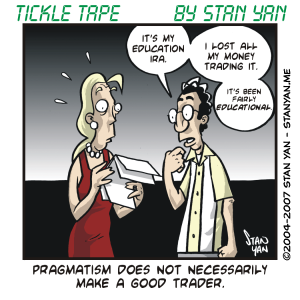On classic episodes of “Star Trek,” Captain Kirk often asked Mr Spock, “How far away is the target?” In his typical reply, Spock gave the exact distance down to at least the fifth decimal place (such as 10.10321 meters). Although it sounds scientific, nothing is measured that precisely. Measurement instruments are rarely that accurate, and such accuracy has no practical purpose since the most measurement is merely a rough estimate at best.
This is especially true when studying the markets, since it’s human behaviour that we are studying, and human behaviour is difficult to measure. I wonder if Mr Spock would make a good trader. He’s cold, logical, and objective about things, so he wouldn’t be swayed by fear, hope, or greed, but would his need for precision and accuracy get the better of him? Nevertheless, when it comes to forecasting market conditions, it makes absolutely no sense to strive for extreme accuracy.
Market prices are based essentially on people’s opinion (and although a company’s profits and assets play a role in the price of a stock, stock prices these days are far above their “true” value, and thus, to a large extent, prices are based primarily on psychological beliefs). Pollsters and other social scientists are the most qualified experts on measuring public opinion, so it may be useful to consider what they know about measuring people’s beliefs and apply this practical knowledge to intuitively assessing the current opinions of market participants and anticipating what they will do next.
When measuring human behaviour, the error is substantial. Have you ever noticed that when a poll is taken, the results consist of two parts: the parameter estimate (for example, 80%) and the standard error (for example, plus or minus 5%)? An estimate of public opinion is merely an “estimate” because (a) not everyone has the exact same opinion and (b) it’s hard to accurately measure an opinion. The variability from these two factors is reflected in the standard error.
At best, a social scientist makes a probabilistic statement based on a few key assumptions. One is that the “sample” represents an actual population. Another is that the measurement of the opinion is reliable. The first assumption is often met because very well developed sampling procedures are used. The second assumption is more suspect. It’s hard to measure an opinion. And even if someone holds a particular opinion, he or she may not act on it. These issues have a direct bearing on trading.
As traders, we are basically trying to assess current opinion, and anticipate what the masses will do based on that opinion. The masses react to what they see and think others are doing, and traders base their decisions on the potential reaction of the masses. So at the core of trading is the notion that the opinion of the masses is measured accurately by the current prices, and that upon seeing the current prices or current market conditions, the masses react in predictable ways; that is, when prices fall, they become fearful and sell off their positions to protect their remaining capital, and buy again when they see prices rise so as to satisfy their greed. Indeed, a central tenet of Dow Theory is that the masses react to specific situations in a consistent and predictable fashion. But there is good reason to doubt whether observed prices do accurately reflect the true opinion of the masses, or whether people do, in fact, react to situations in a consistent manner.
Social scientists claim that there are regularities, or general laws when it comes to understanding human behaviour. Even though a goal of science is to delineate general laws, it is rarely achieved in the social sciences. People are much too complex. Human behaviour is too hard to measure and people don’t always act on their attitudes and beliefs in consistent ways.
Although many social scientists work under the assumption that human behaviour is consistent and predictable, there’s little evidence to support this claim. In an influential analysis, for example, Professors David Funder and Daniel Ozer examined the extent to which people responded consistently to structured situations. They analyzed findings from seminal studies in social psychology, such as studies on conformity, obedience to authority, and the “bystander effect.”
In general, structured situations accounted for only 16% of the variance (out of 100%) in people’s behaviour, which suggests that situations do not account for 84% of the variance in human behaviour (this other 84% is mostly due to individual differences and unreliable measurement). In other words, it’s hard to measure human behaviour, and people do not respond consistently to situations, even standardized well-controlled laboratory situations. So if social scientists can’t measure people’s behaviour with relatively accurate measures in well-controlled standardized situations, and people don’t seem to respond consistently to these situations, how can we expect to measure the behaviour of market participants precisely?
Why should we assume that people would react consistently to particular market conditions (and thus, form the price patterns outlined in classic technical analysis texts)? We probably can’t make the assumption. Sure, there’s some consistency. But it is nothing like the consistency we are used to measuring in the physical world. Our estimates are merely best guesses and potentially inaccurate ones.
So when you are trying to anticipate what the masses of market participants will do, remember that humans are not like rising and falling tides. They are not nearly as predictable as that. When studying human behaviour, and that’s what you’re doing as a trader, there is no such thing as certainty. It’s all just a matter of probabilities. And that means no one will ever know what will happen in the markets next.


